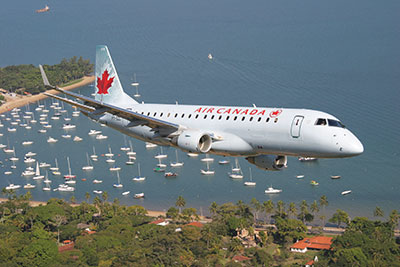
Features
Safety
On Final: Give geese a chance
Like the fabled goose, Canada’s aviation sector needs a viable environment to keep providing its golden eggs – jobs, trade, tourism and revenue – for government.
September 8, 2014 By Marc-André O’Rourke
Like the fabled goose, Canada’s aviation sector needs a viable environment to keep providing its golden eggs – jobs, trade, tourism and revenue – for government. That’s why news that the upcoming Canada Transportation Act (CTA) review will pay special attention to aviation’s competiveness is welcomed by the nation’s airlines.
 |
|
| Aviation has an economic footprint of nearly $35 billion in GDP and supports more than 400,000 jobs. Photo: AIR CANADA |
Launched by Transport Minister Lisa Raitt in June, the CTA review will be chaired by former federal minister, David Emerson. The panel has been asked to examine how to ensure the vitality of Canada’s aviation sector in light of cost factors and competitive global markets. For the nation’s airlines, this is a great opportunity to make the case for an environment that allows aviation to do what it does best – stimulate business, trade and tourism.
Canada’s aviation sector already provides important benefits. Aviation has an economic footprint of nearly $35 billion in GDP and supports more than 400,000 jobs across a broad spectrum of industries. These benefits are significant. But we can do more.
Over the past 20 years, the aviation sector has repeatedly been told that the imposition of a new tax or charge “will only add a small amount” to the airfare and will have no impact on demand. This approach has resulted in Canada having the dubious distinction of being one of the least competitive jurisdictions in the world. Only an ostrich – incidently a bird that does not fly – would believe that such taxes and fees do not have an impact on demand and the economy. We don’t need to look much further than the jobs and dollars that are leaked across the border because of the more than 5 million Canadians who choose to fly out of U.S. airports.
Canada needs a new flight path to enable the aviation sector to realize its potential. This new course must treat the sector as an engine that drives our economy, trade and tourism. Simply put, we need to make it easier and cost competitive to fly, visit and do business in Canada. Here are some key elements:
- Revisit user-pay. The current user-pay approach was implemented more than 20 years ago in a very different time and place. As the Conference Board of Canada points out, “the question now arises as to whether air transportation policy and the extent to which user-pay policy is applied – and potentially user “overpay” – should be reviewed to ensure the sector is achieving its potential.” While we believe the 100 per cent user-pay model needs to be revised in several areas, at the very least, if we are going to have elements of a user pay system then it better be a true user-pay system. This means all revenue collected from the industry must be reinvested in industry.
- Increase trade and tourism. Given air transportation’s role in expanding markets, improvements to Canada’s visa process have significant impact on trade and tourism. Minister Chris Alexander’s recent introduction of CAN+, a program to expedite visa processes for certain Mexican and Indian travellers, is a novel step forward. Used to its full potential, the upcoming electronic Travel Authorization (eTA) program presents another opportunity to increase air travel and economic cooperation. For example, we could facilitate travel for citizens of partner economies such as Mexico, Brazil, Chile and Argentina by asking for an eTA instead of the more burdensome visa.
- Responsive regulations. Canada already has one of the world’s safest air transport systems in the world. This achievement is not the work of chance but is the result of a comprehensive approach to safety taken by all industry stakeholders. As continuous improvement is essential, a more responsive regulatory framework is required to enable airlines to take full advantage of emerging industry best practices and technologies and to optimize safety and environmental efficiencies.
- Reducing our environmental footprint. The development of aviation biofuel is crucial to the industry’s efforts to meet the global goal of carbon-neutral growth by 2020. While we have seen very positive developments on this front, there is no question that significant advances in commercializing biofuels are still needed. Consequently, increased collaboration between industry and government is important.
Emerson and his team are expected to provide their final report in December 2015. We believe they have a tremendous opportunity to strengthen the aviation sector in Canada to connect more communities, attract more visitors and help more Canadian businesses compete globally.
In other words, all we are saying is: give geese a chance.
Marc-André O’Rourke is the Executive Director of the National Airline Council of Canada.